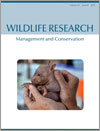Context. Management of wildlife that may simultaneously be of conservation concern and pose problems for humans is difficult, particularly when knowledge of their population dynamics is elusive. Culling of southern hairy-nosed wombats (Lasiorhinus latifrons) is often carried out in agricultural areas, with no understanding of potential impacts on the species as a whole. Monitoring fossorial species via non-invasive means (that do not adversely impact animals by damaging their burrows) has always represented a challenge for wildlife researchers.
Aim. The aim of this research was to map the areal extent of different types of L. latifrons warrens to gain a better understanding of the relationship between the external warren signs and its subterranean structure. The findings will be used in the development of more accurate indices of population abundance to better inform management decisions.
Methods. Ground penetrating radar (GPR) was used to map warrens at four locations in the western regions of South Australia. Radar data were collected using a Mala X3M GPR system with 250 MHz and 500 MHZ antennas. 3D models of each site were then produced using the ReflexW GPR software processing package.
Key results. Subterranean warren structure varied from a mix of tunnel types in sandy-loam soil to a complex array of tunnels and caverns under sheet calcrete limestone.
Conclusions. This was the first non-invasive mapping of wombat warrens and the first mapping of a warren under a layer of calcrete limestone. In sandy-loam soil, the size and extent of the external spoil mound provided some indication of warren complexity. However, there were no external signs of the extent of the calcrete warren.
Implications. The lack of external cues regarding the extent of the calcrete limestone warren suggests that the current method of estimating population abundance based on a single index of wombats per active burrow is flawed. As a result, any management decisions in regard to culling may be based on inaccurate information. It is apparent that further research needs to be undertaken to develop a range of abundance indices that take into account local conditions such as soil type.





